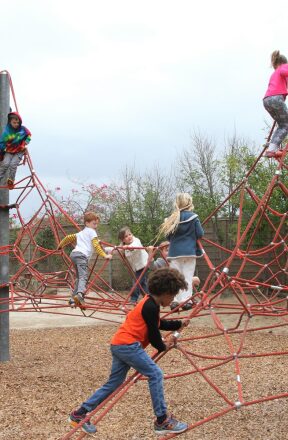FAQ
Developed by Rudolf Steiner in 1919, Waldorf Education is based on a developmental approach which addresses the needs of the growing child and maturing adolescent. Waldorf teachers strive to transform education into an art that educates the whole child—the heart and the hands, as well as the head.
These two educational approaches began with a similar goal: to design a curriculum that was developmentally appropriate to the child and that addressed the child’s need to learn in a tactile as well as an intellectual way. The philosophies are otherwise very different.
Waldorf schools are non-sectarian and non-denominational. They educate all children, regardless of their cultural or religious backgrounds. The pedagogical method is comprehensive, and, as part of its task, seeks to bring about recognition and understanding of all the world cultures and religions. Waldorf schools are not part of any church. They espouse no particular religious doctrine but are based on a belief that there is a spiritual dimension to the human being and to all of life. Waldorf families come from a broad spectrum of religious traditions.
It is easy to fall into the error of believing that education must make our children fit into society. Although we are certainly influenced by what the world brings us, the fact is that the world is shaped by people, not people by the world. However, that shaping of the world is possible in a healthy way only if the shapers are themselves in possession of their full nature as human beings.
Education in our materialistic, Western society focuses on the intellectual aspect of the human being and has chosen largely to ignore the several other parts that are essential to our well-being. These include our life of feeling (emotions, aesthetics, and social sensitivity), our willpower (the ability to get things done), and our moral nature (being clear about right and wrong). Without having these developed, we are incomplete. That is why in a Waldorf school, the practical and artistic subjects play as important a role as the full spectrum of traditional academic subjects that the school offers. The practical and artistic are essential in achieving a preparation for life in the “real” world.
Waldorf Education recognizes and honors the full range of human potentialities. It addresses the whole child by striving to awaken and ennoble all the latent capacities. The children learn to read, write, and do math; they study history, geography, and the sciences. In addition, all children learn to sing, play a musical instrument, draw, paint, model clay, carve and work with wood, speak clearly and act in a play, think independently, and work harmoniously and respectfully with others. The development of these various capacities is interrelated. For example, both boys and girls learn to knit in grade one. Acquiring this basic and enjoyable human skill helps them develop a manual dexterity, which after puberty will be transformed into an ability to think clearly and to “knit” their thoughts into a coherent whole.
Preparation for life includes the development of the well-rounded person. Waldorf Education has as its ideal a person who is knowledgeable about the world and human history and culture, who has many varied practical and artistic abilities, who feels a deep reverence for and communion with the natural world, and who can act with initiative and in freedom in the face of economic and political pressures. There are many Waldorf graduates of all ages who embody this ideal and who are perhaps the best proof of the efficacy of the education.
There is evidence that normal, healthy children who learn to read relatively late are not disadvantaged by this, but rather are able quickly to catch up with, and may overtake, children who have learned to read early. Additionally, they are much less likely to develop the “tiredness toward reading” that many children who are taught to read at a very early age experience later on. Instead, there is lively interest in reading and learning that continues into adulthood. Some children will, out of themselves, want to learn to read at an early age. This interest can and should be met, as long as it comes in fact from the child. Early imposed formal instruction in reading can be a handicap in later years, when enthusiasm toward reading and learning may begin to falter.
If reading is not pushed, a healthy child will pick it up quite quickly and easily. Some Waldorf parents become anxious if their child is slow to learn to read. Eventually these same parents are overjoyed at seeing their child pick up a book and not put it down and become from that moment a voracious reader. Each child has his or her own optimal time for “taking off.” Feelings of anxiety and inferiority may develop in a child who is not reading as well as her peers. Often this anxiety is picked up from parents concerned about the child’s progress. It is important that parents should deal with their own and their child’s apprehensions.
Human growth and development do not occur in a linear fashion, nor can they be measured. What lives, grows, and has its being in human life can only be grasped with that same human faculty that can grasp the invisible metamorphic laws of living nature
Children who transfer to a Waldorf school in the first four grades usually are up to grade in reading, math, and basic academic skills. However, they usually have much to learn in bodily coordination skills, posture, artistic and social activities, cursive handwriting, and listening skills. Listening well is particularly important since most of the curricular content is presented orally in the classroom by the teacher. The human relationship between the child and the teacher is the basis for healthy learning, for the acquiring of understanding and knowledge rather than just information. Children who are used to learning from computers and other electronic media will have to adjust.
Those children who enter a Waldorf school in the middle grades often bring much information about the world. This contribution should be recognized and received with interest by the class. However, these children often have to unlearn some social habits, such as the tendency to experience learning as a competitive activity. They have to learn to approach the arts in a more objective way, not simply as a means for personal expression. In contrast, in their study of nature, history, and the world, they need to relate what they learn to their own life and being. The popular ideal of “objectivity” in learning is misguided when applied to elementary school children. At their stage of development, the subjective element is essential for healthy learning. Involvement in what is learned about the world makes the world truly meaningful to them.
Children who transfer out of a Waldorf school into a public school during the earlier grades probably have to upgrade their reading ability and to approach the science lessons differently. Science in a Waldorf school emphasizes the observation of natural phenomena rather than the formulation of abstract concepts and laws. On the other hand, the Waldorf transferees are usually well prepared for social studies, practical and artistic activities, and mathematics. Children moving during the middle grades should experience no problems. In fact, in most cases, transferring students of this age group find themselves ahead of their classmates. The departing Waldorf student is likely to take along into the new school a distinguishing individual strength, personal confidence, and love of learning.
A central aim of Waldorf Education is to stimulate the healthy development of the child’s own imagination. Electronic media hampers the development of the child’s imagination. Waldorf teachers are concerned about the physical effects of the medium on the developing child as well as the content of much of the programming.
Technology use among young children is discouraged. Waldorf teachers feel that at this age, a personal, human touch is more appropriate. It is more important for students to have the opportunity to interact with one another and with teachers in exploring the world of ideas, participating in the creative process, and developing their knowledge, skills, abilities, and inner qualities. Waldorf students have a love of learning, an ongoing curiosity, and interest in life. Students in grades 6-8 may research the internet for writing reports. In High School, they use computers and quickly master computer technology; many graduates have successful careers in the computer industry.
Waldorf students have been accepted into and graduated from a broad spectrum of colleges and universities including Stanford, UC Berkeley, Harvard, Yale, and Brown. Waldorf graduates reflect a wide diversity of professions and occupations including medicine, law, science, engineering, computer technology, the arts, social science, government, and teaching at all levels.
Highland Hall complies with all California vaccination and reporting laws, including the recent amendment to California Health & Safety code 120325 (c) which no longer allows exemptions for personal beliefs.





